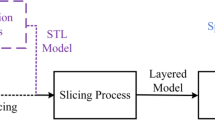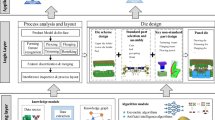Summary
We present an optimal algorithm to determine whether a placement of N isothetic non-overlapping rectangles (macros) can be represented by a slicing tree, and if so, to find a representation of minimal height. A slicing is a recursive partition of the overall bounding rectangle, by straight horizontal or vertical cuts, into rectangular regions, each one containing exactly one macro. The algorithm first determines a representation of the empty space of the placement by means of maximally extended horizontal and vertical channels. A second phase then generates a maximal slicing tree (an ordered tree with unbounded degree and maximal branching, i.e., minimal height) in a top-down fashion. The complexity of each phase is O(N log N). The problem arises in steps (1) and (2) of our top-down approach to VLSI custom chip design, which consists of (1) floorplanning by slicing, (2) hierarchicial global wiring, and (3) detailed layout of macros.
Similar content being viewed by others
References
Kimura, S., Kubo, N., Chiba, T., Nishioka, I.: An automatic routing scheme for general cell LSI. IEEE Trans. CAD-2 4, 285–292 (1983)
Lee, D.T., Preparata, F.P.: Computational geometry — a survey. IEEE Trans. Comput. C-33 12, 1072–1101 (1984)
Liu, W., Atkins, D.E.: On the routability and channel routing order of a general cell approach. Proc. IEEE International Conference on Circuits and Computers ICCC 82, pp. 246–249. New York 1982
Luk, W.K., Sipala, P., Tamminen, M., Tang, D., Woo, L., Wong, C.K.: A global wiring algorithm for slicing structures. IBM Research Report 1985 (To appear)
Mantyla, M.: An Introduction to Solid Modeling. (To be published by Computer Science Press)
Otten, R.H.J.M.: Layout structures. Research Report RC 9657, IBM Thomas J. Watson Research Center, Yorktown Heights, NY 1982
Ousterhout, J.K.: Corner stitching: a data-structuring technique for VLSI layout tools, IEEE Trans. CAD-3 1, 87–100 (1984)
Schlag, M., Luccio, F., Maestrini, P., Lee, D.T., Wong, C.K.: A visibility problem in VLSI layout compaction. In: Advances in Computing Research, Vol.2 — VLSI Theory, pp. 259–282. Greenwich, CT: JAI Press 1984
Stockmeyer, L.J.: Optimal orientations of cells in slicing floorplan designs. Inf. Control. 57, 91–101 (1983)
Supowit, K.J., Slutz, E.A.: Placement algorithms for custom VLSI. Comput. Aided Design 16, 45–50 (1984)
Valdes, J., Tarjan, R.E., Lawler, E.L.: The recognition of series parallel digraphs, Proc. Eleventh Annual ACM Symposium on Theory of Computing, Atlanta, Georgia, 1–11 (1979)
Author information
Authors and Affiliations
Additional information
On leave from: Laboratory of Information Processing Science, Helsinki University of Technology, Espoo, Finland
On leave from: Dipartimento di Elettrotecnica, Elettronica e Informatica, Università degli Studi di Trieste, Via Valerio, 10-34127 Trieste, Italy
Rights and permissions
About this article
Cite this article
Tamminen, M., Luk, W.K., Sipala, P. et al. Constructing maximal slicings from geometry. Acta Informatica 23, 267–288 (1986). https://doi.org/10.1007/BF00289114
Received:
Issue Date:
DOI: https://doi.org/10.1007/BF00289114




